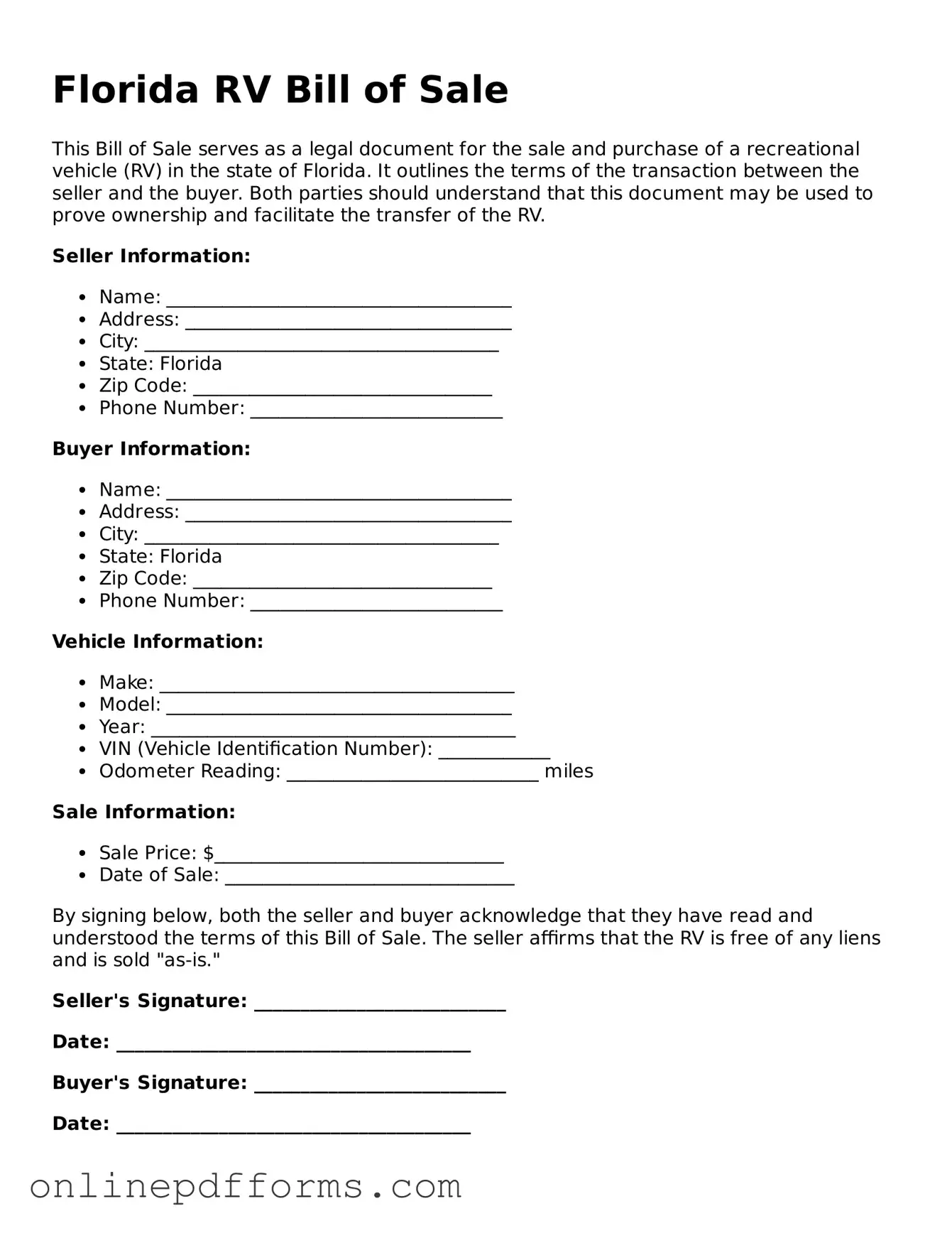The Florida RV Bill of Sale is similar to a standard Vehicle Bill of Sale, which serves as a record of the transfer of ownership for any motor vehicle. This document typically includes details about the vehicle, such as its make, model, year, and Vehicle Identification Number (VIN). Like the RV Bill of Sale, it provides essential information about the buyer and seller, ensuring that both parties have a clear understanding of the transaction. Both documents help protect the interests of the buyer and seller by serving as proof of the sale and can be used for registration purposes.
Another similar document is the Boat Bill of Sale. This form is used when transferring ownership of a boat, much like the RV Bill of Sale does for recreational vehicles. It includes key details about the boat, such as its hull identification number, length, and type. Both documents facilitate the transfer process and provide a legal record of the transaction, which can be important for future registrations or in case of disputes.
The Motorcycle Bill of Sale shares many similarities with the RV Bill of Sale as well. This document outlines the specifics of a motorcycle sale, including the motorcycle's make, model, year, and VIN. Just like the RV Bill of Sale, it serves as a legal record of the transaction, protecting both the buyer and seller. It can also be used for title transfer and registration, ensuring that the new owner can legally operate the motorcycle on public roads.
The Trailer Bill of Sale is another document that resembles the RV Bill of Sale. When someone sells or buys a trailer, this form provides a record of the transaction. It includes information about the trailer, such as its type, size, and VIN. Both documents serve to confirm the sale and protect the interests of both parties, making them essential for ensuring a smooth transfer of ownership.
A Boat Registration Application is similar in purpose to the RV Bill of Sale, as both are involved in the ownership transfer process. While the RV Bill of Sale serves as proof of purchase, the Boat Registration Application is used to officially register the boat with the state. Both documents require details about the vehicle and its owner, ensuring that the state has accurate records of ownership for legal and safety purposes.
The Lease Agreement for a recreational vehicle also shares similarities with the RV Bill of Sale. While a Bill of Sale indicates a transfer of ownership, a lease agreement outlines the terms under which a recreational vehicle is rented. Both documents include important details about the vehicle and the parties involved. They serve to protect the rights and responsibilities of each party, ensuring clarity in the transaction.
The Warranty Deed is another document that, while typically associated with real estate, shares the concept of transferring ownership. Like the RV Bill of Sale, a Warranty Deed provides a legal record of a transaction. It guarantees that the seller has the right to sell the property and that the buyer will receive clear title. Both documents serve as important legal records that help protect the interests of the parties involved.
When dealing with any vehicle transaction, including RVs, it is essential to ensure all necessary documentation is completed accurately. The Texas RV Bill of Sale form provides a clear record of ownership transfer and protects both parties involved in the sale. To better understand how to fill out this critical document, you can read more about the specifics of its use and requirements.
The Personal Property Bill of Sale is akin to the RV Bill of Sale in that it can be used for various types of personal property transactions, not just vehicles. This document provides a record of the sale and includes information about the item being sold, the buyer, and the seller. It serves a similar purpose in documenting the transfer of ownership and can be used in disputes or for registration purposes.
The Gift Letter, while different in nature, can be compared to the RV Bill of Sale in terms of documenting the transfer of ownership. A Gift Letter is used when a vehicle is given as a gift rather than sold. It includes details about the vehicle and the parties involved, similar to the RV Bill of Sale. Both documents help clarify the ownership status and can be important for title transfer and registration.
Lastly, the Affidavit of Ownership is similar to the RV Bill of Sale in that it provides a formal declaration of ownership. This document may be used when someone cannot provide a traditional Bill of Sale or when the original title is lost. It includes relevant details about the vehicle and the owner, serving as a legal statement of ownership. Both documents are crucial for ensuring that ownership is clearly established and recognized by authorities.
